



 rendu possible grâce à la participation financière du Conseil de recherches en sciences humaines
rendu possible grâce à la participation financière du Conseil de recherches en sciences humaines 
Nous sommes un partenariat composé de chercheurs, de professionnels du soutien en emploi, d'organisations communautaires, de personnes autistes, et de proches de personnes autistes. Nous travaillons ensemble pour promouvoir l’emploi inclusif.
Nous avons créé ces infographies basées sur la recherche. Notre objectif est de fournir des informations accessibles et fiables qui peuvent être utilisées par tous ceux dont la contribution est essentielle pour améliorer les opportunités d'emploi pour les personnes autistes ou ayant une déficience intellectuelle.
S'il vous plaît, aidez-nous à diffuser ces infographies!
Nous sommes un partenariat composé de chercheurs, de professionnels du soutien en emploi, d'organisations communautaires, de personnes autistes, et de proches de personnes autistes. Nous travaillons ensemble pour promouvoir l’emploi inclusif.
Nous avons créé ces infographies basées sur la recherche. Notre objectif est de fournir des informations accessibles et fiables qui peuvent être utilisées par tous ceux dont la contribution est essentielle pour améliorer les opportunités d'emploi pour les personnes autistes ou ayant une déficience intellectuelle.
S'il vous plaît, aidez-nous à diffuser ces infographies!
Nous sommes un partenariat composé de chercheurs, de professionnels du soutien en emploi, d'organisations communautaires, de personnes autistes, et de proches de personnes autistes. Nous travaillons ensemble pour promouvoir l’emploi inclusif.
Nous avons créé ces infographies basées sur la recherche. Notre objectif est de fournir des informations accessibles et fiables qui peuvent être utilisées par tous ceux dont la contribution est essentielle pour améliorer les opportunités d'emploi pour les personnes autistes ou ayant une déficience intellectuelle.
S'il vous plaît, aidez-nous à diffuser ces infographies!
Nous sommes un partenariat composé de chercheurs, de professionnels du soutien en emploi, d'organisations communautaires, de personnes autistes, et de proches de personnes autistes. Nous travaillons ensemble pour promouvoir l’emploi inclusif.
Nous avons créé ces infographies basées sur la recherche. Notre objectif est de fournir des informations accessibles et fiables qui peuvent être utilisées par tous ceux dont la contribution est essentielle pour améliorer les opportunités d'emploi pour les personnes autistes ou ayant une déficience intellectuelle.
S'il vous plaît, aidez-nous à diffuser ces infographies!
Nous sommes un partenariat composé de chercheurs, de professionnels du soutien en emploi, d'organisations communautaires, de personnes autistes, et de proches de personnes autistes. Nous travaillons ensemble pour promouvoir l’emploi inclusif.
Nous avons créé ces infographies basées sur la recherche. Notre objectif est de fournir des informations accessibles et fiables qui peuvent être utilisées par tous ceux dont la contribution est essentielle pour améliorer les opportunités d'emploi pour les personnes autistes ou ayant une déficience intellectuelle.
S'il vous plaît, aidez-nous à diffuser ces infographies!
Nous sommes un partenariat composé de chercheurs, de professionnels du soutien en emploi, d'organisations communautaires, de personnes autistes, et de proches de personnes autistes. Nous travaillons ensemble pour promouvoir l’emploi inclusif.
Nous avons créé ces infographies basées sur la recherche. Notre objectif est de fournir des informations accessibles et fiables qui peuvent être utilisées par tous ceux dont la contribution est essentielle pour améliorer les opportunités d'emploi pour les personnes autistes ou ayant une déficience intellectuelle.
S'il vous plaît, aidez-nous à diffuser ces infographies!
Nous sommes un partenariat composé de chercheurs, de professionnels du soutien en emploi, d'organisations communautaires, de personnes autistes, et de proches de personnes autistes. Nous travaillons ensemble pour promouvoir l’emploi inclusif.
Nous avons créé ces infographies basées sur la recherche. Notre objectif est de fournir des informations accessibles et fiables qui peuvent être utilisées par tous ceux dont la contribution est essentielle pour améliorer les opportunités d'emploi pour les personnes autistes ou ayant une déficience intellectuelle.
S'il vous plaît, aidez-nous à diffuser ces infographies!
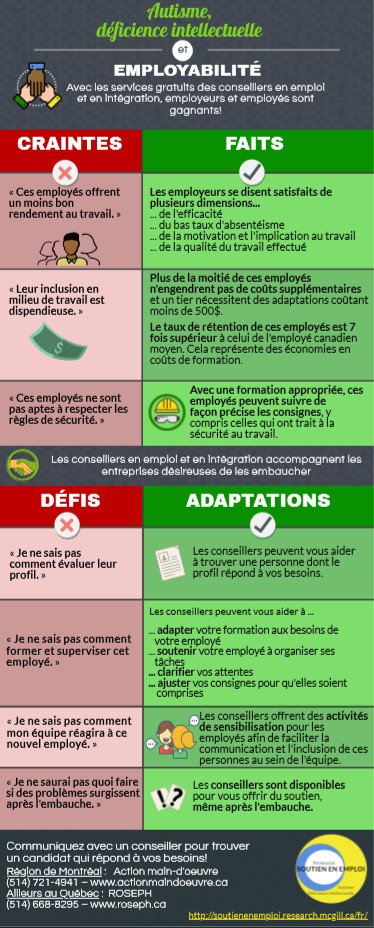
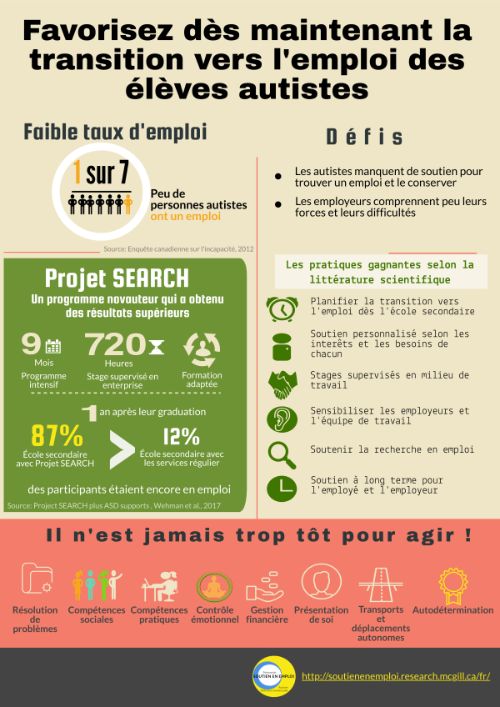
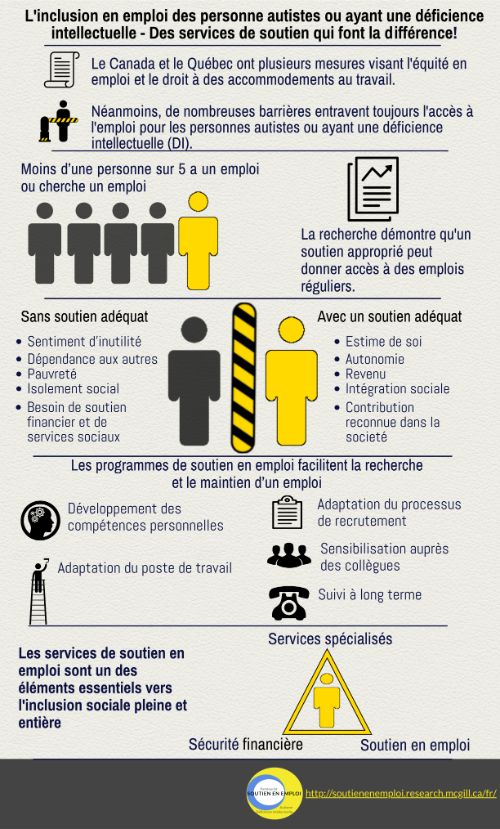
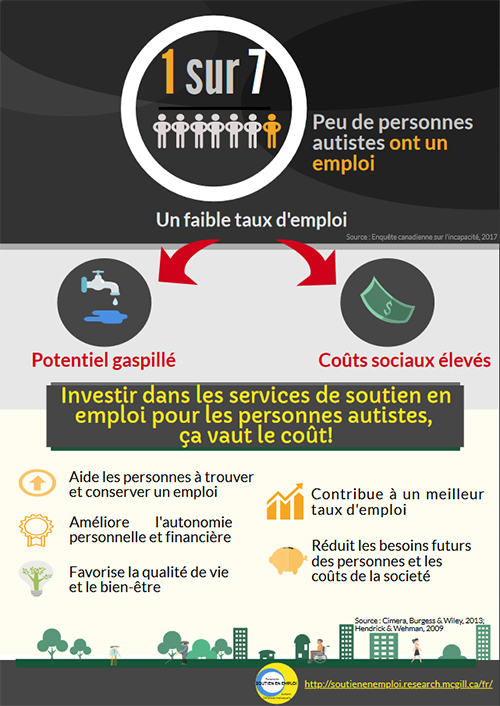
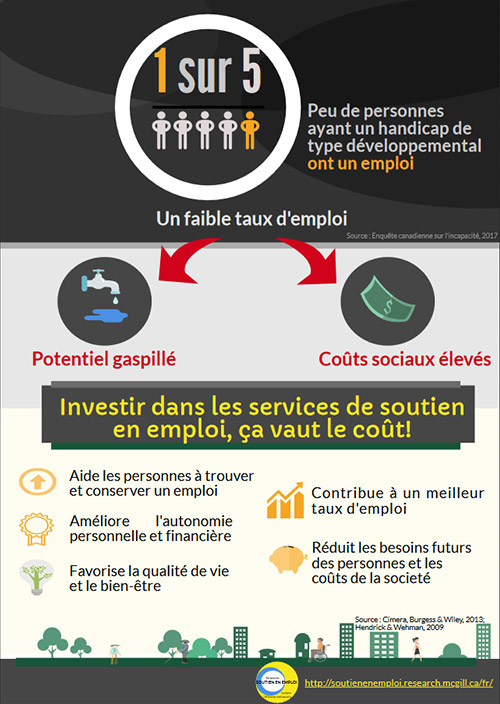
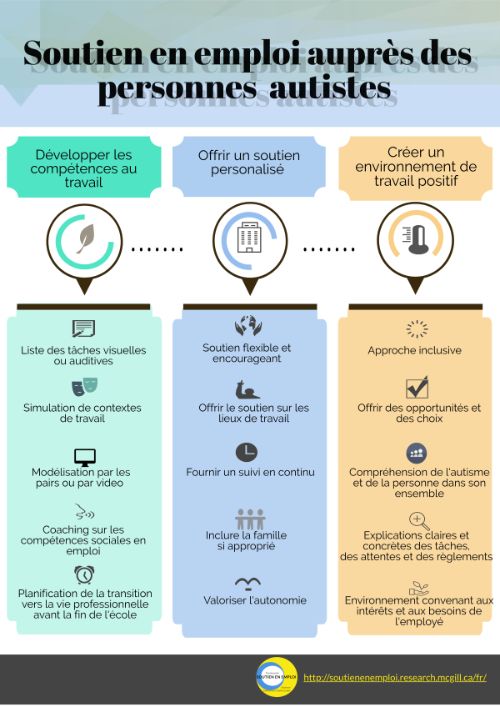
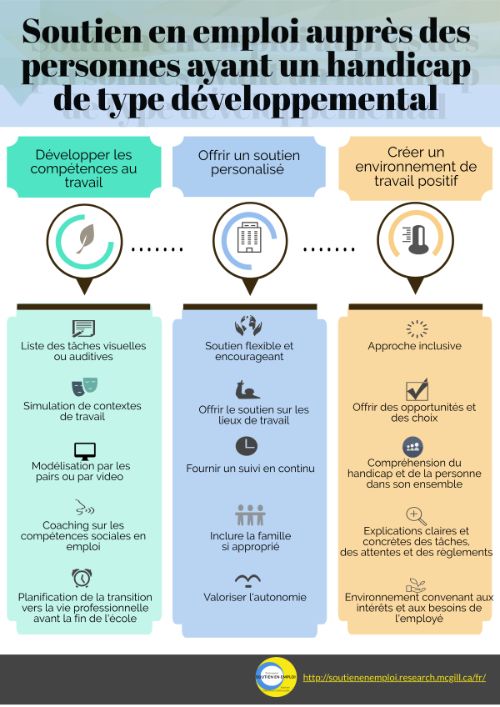
Nous sommes un partenariat composé de chercheurs, de professionnels du soutien en emploi, d'organisations communautaires, de personnes autistes, et de proches de ces personnes. Nous travaillons ensemble pour promouvoir l'emploi inclusif pour les personnes autistes ou ayant une déficience intellectuelle. Nous avons créé ces infographies basées sur la recherche. Notre objectif est de fournir des informations accessibles et fiables qui peuvent être utilisées par tous ceux dont la contribution est essentielle pour améliorer les opportunités d'emploi.
S'il vous plaît, aidez-nous à diffuser ces infographies!
Nous sommes heureux de pouvoir compter sur votre collaboration pour promouvoir l'emploi inclusif!
Les références récentes sont précédées d'une étoile *
*Government of Canada. (2018). Autism Spectrum Disorder among Children and Youth in Canada 2018: A Report of the National Autism Spectrum Disorder Surveillance System. Retrieved from https://www.canada.ca/en/public-health/services/publications/diseases-conditions/autism-spectrum-disorder-children-youth-canada-2018.html
*Martin, Valérie. La situation d’emploi des personnes ayant un TSA. Fiche synthèse 1. Février (2018) Réseau national d’expertise en trouble du spectre de l’autisme, disponible en ligne au [http://www.rnetsa.ca/domaines-des-tsa/emploi-2]
Nord, D. K., Stancliffe, R. J., Nye-Lengerman, K., & Hewitt, A. S. (2016). Employment in the community for people with and without autism: A comparative analysis. Research in Autism Spectrum Disorders, 24, 11-16.
Office Des Personnes Handicapées Du Québec (2018). Les programmes et mesures destinés aux personnes handicapées : portrait global et dépenses : 2017-2018, Drummondville, Secrétariat général, L’Office, 33 p.
Ross, J., Marcell, J., Williams, P., & Carlson, D. (2013). Postsecondary Education Employment and Independent Living Outcomes of Persons with Autism and Intellectual Disability. Journal of Postsecondary Education and Disability, 26(4), 337-351.
Roux, A. M., Shattuck, P. T., Rast, J. E., Rava, J. A., & Anderson, K. A. (2015). National autism Indicators report: Transition into young adulthood. Life Course Outcomes Research Program’, AJ Drexel Autism Institute, Drexel University, Philadelphia, PA.
Roux, A. M., Rast, J. E., Anderson, K. A., & Shattuck, P. T. (2017). National autism indicators report: Developmental disability services and outcomes in adulthood. Philadelphia, PA.: Life Course Outcomes Program, A.J. Drexel Autism Institute, Drexel University.
Statistics Canada. (2012). Labour force status for adults with disabilities by disability type. (Table 13-10-0348-01). Retrieved October 27, 2019 from https://www150.statcan.gc.ca/t1/tbl1/en/tv.action?pid=1310034801&pickMembers%5B0%5D=1.1&pickMembers%5B1%5D=2.1&pickMembers%5B2%5D=3.1&pickMembers%5B3%5D=5.1
Statistics Canada. (2018) Persons with and without disabilities aged 15 years and over, by age group and sex, Canada, provinces and territories. (Table: 13-10-0374-01). Retrieved October 27,, 2019 from https://www150.statcan.gc.ca/n1/pub/89-654-x/89-654-x2018002-eng.pdf
Zwicker, J., Zaresani, A., & Emery, J. H. (2017). Describing heterogeneity of unmet needs among adults with a developmental disability: an examination of the 2012 Canadian survey on disability. Research in developmental disabilities, 65, 1-11.
Les références récentes sont précédées d'une étoile *
Bennett, K. D., & Dukes, C. (2013). Employment instruction for secondary students with autism spectrum disorder: A systematic review of the literature. Education and Training in Autism and Developmental Disabilities, 67-75. Retrieved from http://www.jstor.org/stable/23879887
Lee, G. K., & Carter, E. W. (2012). Preparing Transition‐Age Students with High‐Functioning Autism Spectrum Disorders for Meaningful Work. Psychology in the Schools, 49(10), 988-1000. doi: 10.1002/pits.21651
Butterworth, J., Hagner, D., Helm, D. T., & Whelley, T. A. (2000). Workplace culture, social interactions, and supports for transition-age young adults. Mental Retardation, 38(4), 342-353.
Parr, A. D., & Hunter, S. T. (2014). Enhancing work outcomes of employees with autism spectrum disorder through leadership: Leadership for employees with autism spectrum disorder. Autism, 18(5), 545- 554. doi: 10.1177/1362361313483020
Pozzebon, S., & Champagne, M. (2009). L'intégration professionnelle des personnes handicapées : que font les organisations avant-gardistes? Gestion, 34(3), 103. doi:10.3917/riges.343.
Dotto-Fojut, K. M., Reeve, K. F., Townsend, D. B., & Progar, P. R. (2011). Teaching adolescents with autism to describe a problem and request assistance during simulated vocational tasks. Research in Autism Spectrum Disorders, 5(2), 826-833. doi:10.1016/j.rasd.2010.09.012
Gentry, T., Kriner, R., Sima, A., McDonough, J., & Wehman, P. (2015). Reducing the need for personal supports among workers with autism using an iPod touch as an assistive technology: Delayed randomized control trial. Journal of autism and developmental disorders, 45(3), 669-684. doi: 10.1007/s10803-014-2221-8
Hall, J., Morgan, R. L., & Salzberg, C. L. (2014). Job preference and job-matching assessment results and their association with job performance and satisfaction among young adults with developmental disabilities. Education and Training in Autism and Developmental Disabilities, 49(2), 301.
Morgan, L., Leatzow, A., Clark, S., & Siller, M. (2014). Interview skills for adults with autism spectrum disorder: a pilot randomized controlled trial. Journal of autism and developmental disorders, 44(9), 2290-2300. doi:10.1007/s10803-014-2100-3
Mozingo, D., Ackley, G. B., & Bailey, J. S. (1994). Training quality job interviews with adults with developmental disabilities. Research in developmental disabilities, 15(5), 389-410. doi: 10.1016/0891- 4222(94)90024-8
Smith, M. J., Ginger, E. J., Wright, K., Wright, M. A., Taylor, J. L., Humm, L. B., ...& Fleming, M. F. (2014). Virtual reality job interview training in adults with autism spectrum disorder. Journal of autism and developmental disorders, 44(10), 2450-2463. doi:10.1007/s10803-014-2113-y
Smith, M. J., Fleming, M. F., Wright, M. A., Losh, M., Humm, L. B., Olsen, D., & Bell, M. D. (2015). Brief report: Vocational outcomes for young adults with autism spectrum disorders at six months after virtual reality job interview training. Journal of Autism and Developmental Disorders, 45(10), 3364-3369.
*Hedley, D., Uljarević, M., Cameron, L., Halder, S., Richdale, A., & Dissanayake, C. (2017). Employment programmes and interventions targeting adults with autism spectrum disorder: A systematic review of the literature. Autism, 21(8), 929-941.
Nicholas, D. B., Attridge, M., Zwaigenbaum, L., & Clarke, M. (2014). Vocational support approaches in autism spectrum disorder: A synthesis review of the literature. Autism, 19, 235-245. doi:0.1177/1362361313516548
*Nicholas, D. B., Mitchell, W., Dudley, C., Clarke, M., & Zulla, R. (2018). An ecosystem approach to employment and autism spectrum disorder. Journal of autism and developmental disorders, 48(1), 264-275.
*Scott, M., Milbourn, B., Falkmer, M., Black, M., Bӧlte, S., Halladay, A., ... & Girdler, S. (2019). Factors impacting employment for people with autism spectrum disorder: A scoping review. Autism, 23(4), 869-901.
Westbrook, J. D., Fong, C. J., Nye, C., Williams, A., Wendt, O., & Cortopassi, T. (2015). Transition Services For Youth With Autism A Systematic Review. Research on Social Work Practice, 25(1), 10-20. doi: 10.1177/ 1049731514524836
Wilczynski, S. M., Trammell, B., & Clarke, L. S. (2013). Improving employment outcomes among adolescents and adults on the autism spectrum. Psychology in the Schools, 50(9), 876-887. doi:10.1002/pits.21718
Howlin, P., Alcock, J., & Burkin, C. (2005). An 8 year follow-up of a specialist supported employment service for high-ability adults with autism or Asperger syndrome. Autism, 9(5), 533-549. doi: 10.1177/1362361305057871
Luecking, D. M., & Luecking, R. G. (2015). Translating research into a seamless transition model. Career Development and Transition for Exceptional Individuals, 38(1), 4-13.
Kerachsky, S., & Thornton, C. (1987). Findings from the STETS transitional employment demonstration. Exceptional Children, 53(6), 515-521. doi: 10.1177/2165143413508978
Shogren, K. A., Forber-Pratt, A. J., Nittrouer, C., & Aragon, S. R. (2013). The emergence of a human services cooperative to support families and young adults with disabilities: Implications for disability services and supports. Research and Practice for Persons with Severe Disabilities, 38(4), 259-273. doi: 10.1177/154079691303800405
Strickland, D. C., Coles, C. D., & Southern, L. B. (2013). JobTIPS: A transition to employment program for individuals with autism spectrum disorders. Journal of autism and developmental disorders, 43(10), 2472-2483. doi: 10.1007/s10803-013- 1800-4
Wehman, P. H., Schall, C. M., McDonough, J., Kregel, J., Brooke, V., Molinelli, A., ... & Thiss, W. (2014). Competitive employment for youth with autism spectrum disorders: Early results from a randomized clinical trial. Journal of autism and developmental disorders, 44(3), 487-500. doi: 10.1007/s10803-013-1892-x
*Wehman, P., Schall, C., McDonough, J., Sima, A., Brooke, A., Ham, W., ... & Riehle, E. (2019). Competitive Employment for Transition-Aged Youth with Significant Impact from Autism: A Multi-site Randomized Clinical Trial. Journal of autism and developmental disorders, 1-16.
Les références récentes sont précédées d'une étoile *
Akkerman, A., Janssen, C. G., Kef, S., & Meininger, H. P. (2014). Perspectives of employees with intellectual disabilities on themes relevant to their job satisfaction. An explorative study using Photovoice. Journal of Applied Research in Intellectual Disabilities, 27(6), 542-554. doi: 10.1111/jar.12092
Akkerman, A., Janssen, C. G., Kef, S., & Meininger, H. P. (2016). Job satisfaction of people with intellectual disabilities in integrated and sheltered employment: An exploration of the literature. Journal of Policy and Practice in Intellectual Disabilities, 13(3), 205-216. doi:10.1111/jppi.12168
*Ellenkamp, J. J., Brouwers, E. P., Embregts, P. J., Joosen, M. C., & van Weeghel, J. (2016). Work environment-related factors in obtaining and maintaining work in a competitive employment setting for employees with intellectual disabilities: A systematic review. Journal of occupational rehabilitation, 26(1), 56-69.
Flores, N., Jenaro, C., Begoña Orgaz, M., & Victoria Martín, M. (2011). Understanding quality of working life of workers with intellectual disabilities. Journal of Applied Research in Intellectual Disabilities, 24(2), 133-141. doi:10.1111/j.1468-3148.2010.00576.x
*Hedley, D., Cai, R., Uljarevic, M., Wilmot, M., Spoor, J. R., Richdale, A., & Dissanayake, C. (2018). Transition to work: Perspectives from the autism spectrum. Autism, 22(5), 528-541.
Hurlbutt, K., & Chalmers, L. (2004). Employment and adults with Asperger syndrome. Focus on Autism and Other Developmental Disabilities, 19(4), 215-222. doi:10.1177/10883576040190040301
Kamens, M. W., Dolyniuk, C. A., Dinardo, P., Rockoff, J. C., Forsythe, J., & Corman, H. (2004). A collaborative approach to enhancing employment and social skills of students with disabilities: Perspectives of the stakeholders. Preventing School Failure: Alternative Education for Children and Youth,48(2), 24-30.
Lorenz, T., Frischling, C., Cuadros, R., & Heinitz, K. (2016). Autism and overcoming job barriers: Comparing job-related barriers and possible solutions in and outside of autism-specific employment. PloS one, 11(1), e0147040.
Müller, E., Schuler, A., Burton, B. A., & Yates, G. B. (2003). Meeting the vocational support needs of individuals with Asperger syndrome and other autism spectrum disabilities. Journal of Vocational Rehabilitation, 18(3), 163-175.
Parsons, S. (2015). ‘Why are we an ignored group?’ Mainstream educational experiences and current life satisfaction of adults on the autism spectrum from an online survey. International Journal of Inclusive Education, 19(4), 397-421. doi: 10.1080/13603116.2014.935814
Hagner, D., & Cooney, B. F. (2005). “I do that for everybody”: Supervising employees with autism. Focus on Autism and Other Developmental Disabilities, 20(2), 91- 97. doi: 10.1177/ 108835760 50200020501
Irvine, A., & Lupart, J. (2008). Into the Workforce: Employers' Perspectives of Inclusion. Developmental Disabilities Bulletin, 36, 225- 50.
Kocman, A., Fischer, L., & Weber, G. (2017). The employers’ perspective on barriers and facilitators to employment of people with intellectual disability: A differential mixed‐method approach. Journal of Applied Research in Intellectual Disabilities. doi:10.1111/jar.12375
Morgan, R. L., & Alexander, M. (2005). The employer's perception: Employment of individuals with developmental disabilities. Journal of Vocational Rehabilitation, 23(1), 39-49.
*Scott, M., Jacob, A., Hendrie, D., Parsons, R., Girdler, S., Falkmer, T., & Falkmer, M. (2017). Employers’ perception of the costs and the benefits of hiring individuals with autism spectrum disorder in open employment in Australia. PloS one, 12(5), e0177607.
*Scott, M., Falkmer, M., Girdler, S., & Falkmer, T. (2015). Viewpoints on factors for successful employment for adults with autism spectrum disorder. PloS one, 10(10), e0139281.
Ward, K. M., Dowrick, P. W., & Weyland, A. (1993). Job coach follow-along activities: Analysis and recommendations. Developmental Disabilities Bulletin.
Les références récentes sont précédées d'une étoile *
Cimera, R., Burgess, S., & Wiley, A. (2013). Does providing transition services early enable students with ASD to achieve better vocational outcomes as adults? Research and Practice for Persons with Severe Disabilities, 38(2), 88-93.
Hendricks, D. R., & Wehman, P. (2009). Transition from school to adulthood for youth with autism spectrum disorders: Review and recommendations. Focus on autism and other developmental disabilities, 24(2), 77-88.
*Jacob, A., Scott, M., Falkmer, M., & Falkmer, T. (2015). The costs and benefits of employing an adult with autism spectrum disorder: A systematic review. PloS one, 10(10), e0139896.
Lawer, L., Brusilovskiy, E., Salzer, M. S., & Mandell, D. S. (2009). Use of vocational rehabilitative services among adults with autism. Journal of autism and developmental disorders, 39(3), 487- 494. doi: 10.1007/s10803-008- 0649-4
Leigh, J., & Du, J. (2015). Brief report: Forecasting the economic burden of autism in 2015 and 2025 in the united states. Journal of Autism and Developmental Disorders, 45(12), 4135-4139. doi:10.1007/s10803-015-2521-7
Mavranezouli, I., Megnin-Viggars, O., Cheema, N., Howlin, P., Baron-Cohen, S., & Pilling, S. (2013). The cost-effectiveness of supported employment for adults with autism in the United Kingdom. Autism, 18, 975-984. doi: 10.1177/1362361313505720e,11(1), e0147040
McInnes, M., Demet Ozturk, O., McDermott, S., & Mann, J. R. (2010). Does supported employment work? Journal of Policy Analysis and Management, 29(3), 506-525. doi: 10.1002/pam.20507
Rogge, N., & Janssen, J. (2019). The economic costs of autism spectrum disorder: A literature review. Journal of Autism and Developmental Disorders, 49(7), 2873-2900. doi:10.1007/s10803-019-04014-z
Schaller, J., & Yang, N. K. (2005). Competitive employment for people with autism correlates of successful closure in competitive and Supported Employment. Rehabilitation Counseling Bulletin, 49(1), 4-16.
*Wehman, P., Chan, F., Ditchman, N., & Kang, H. J. (2014). Effect of supported employment on Vocational rehabilitation outcomes of transition-age youth with intellectual and developmental disabilities: A case control study. Intellectual and developmental disabilities, 52(4), 296-310. doi:10.1352/1934-9556-52.4.296











Laissez un commentaire
Dites-nous comment vous utiliserez ces infographies.